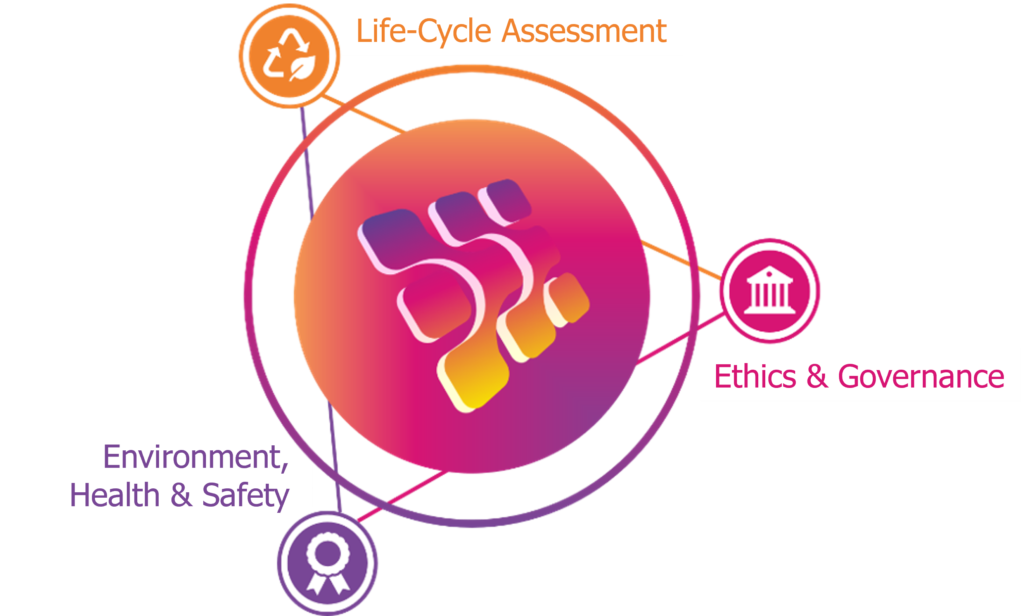Seeking to provide help to EU-funded projects dealing with sustainable nanofabrication, the new NanoFabNet Implementation Roadmap for EU-Project Collaboration includes a series of core components and enablers to advance its goal in a meaningful way:
- Partnerships & Collaborations: these are critical to unlocking the full potential of any EU-funded project. New and innovative collaborative models must be identified to bring together or put in contact different EU-projects alongside other stakeholders like industry, policy makers and civil society.
- Data & Knowledge Generation: obtaining access to reliable and timely data or state-of-the-art knowledge is a key component to successfully achieve the aims and goals of any research and innovation (R&I) project. Data is needed to understand the starting point of any project. In all likelihood, the data or knowledge a project requires may not exist for all targets and indicators, and – even when it does exist – it may exist in varying levels of quality and accessibility. This must be addressed through actions related to capacity building and by enabling channels of data-exchange between projects, such as envisaged by the GO FAIR-initiative[1].
- Innovation: many times, the solutions or needs related to sustainable nanofabrication may either not yet exist or be in very early stages of development. In part, the technological innovation and the scaling up of new processes and/ or products continuously arise from R&I projects and is transforming and advancing the field of sustainable nanofabrication. Therefore, supporting the innovation capacity of the EU-funded projects through enhancing and facilitating collaboration among them is crucial to move forward in the right direction and timely manner. This will help to put Europe in an advanced position in the field of sustainable nanofabrication.
The NanoFabNet Implementation Roadmap for EU-Project Collaboration has been created by expert of the BioNanoNet using information that has been gathered through different activities performed within the NanoFabNet Project, like:
- Mapping and listing of former and current EU-funded projects relevant for the sustainable nanofabrication field,
- Active dialogue with NanoFabNet’s stakeholders maintained during the 1st and 2nd Development Workshops, including a posterior analysis from the feedback,
- Integration of complementary actions planned and/or undergone with other R&I initiatives like the NanoSafety Cluster[2] (NSC), the EURONanoLAB initiative[3] and EURAMET[4], to develop collaborations to widen and strengthen the sustainable nanofabrication field across Europe.

The NanoFabNet Project has defined its own concept of Sustainability in Nanotechnology and Nanofabrication, that will be also adopted and promoted within the NanoFabNet Hub. This concept rests on 3 strong and well-identified pillars. These pillars are:
- Environment, Health & Safety issues in Nanotechnology & Nanofabrication,
- Life Cycle Sustainability (LCA) in Nanotechnology & Nanofabrication, and
- Ethics and Governance issues in Nanotechnology & Nanofabrication.
[1] GO FAIR: https://www.go-fair.org/fair-principles/
[2] NanoSafety Cluster: https://www.nanosafetycluster.eu/
[3] EURONanoLAB: http://euronanolab.eu/
[4] EURAMET: https://www.euramet.org/
About the NanoFabNet:
The NanoFabNet Project aims to set up a self-sustaining once-stop-shop for all matters and concerns pertaining to sustainable nanofabrication and its successful incorporation into the complex, large-scale high-value industries by bringing together governmental and academic laboratories with large industries and SMEs, and thereby offering a coordination space for past, current and future collaborative nanofabrication projects (incl. both EU-funded projects and initiatives, as well as public-to-public partnerships (P2Ps) and public-private-partnerships (PPPs)): the NanoFabNet Hub.
The NanoFabNet ultimately aims to become an international hub for sustainable nanofabrication whose structure, business model, detailed strategies and actions plans are designed, agreed and carried by its partners and stakeholders. The NanoFabNet Hub is a virtual collaboration space, and will be a self-sustained platform that aids any interested actor or stakeholder in accessing expert knowledge about ethical, safe and sustainable nanofabrication. Moreover, a registered NanoFabNet secretariat at the centre of the Hub will provide an accountable executive that secures its economic sustainability.
The digital platform itself of the NanoFabNet Hub will be hosted on NanoFabNet’s website and is an important tool for nanotechnology professionals and entities.
The NanoFabNet Hub envisages to stand for:
- a well implemented, guided approach to high levels of safety and sustainability,
- trusted technical reliability and quality, and
- compliance with and drive of harmonisation, standardisation and regulation requirements, amongst all of its members as well as along their nanofabrication value chains.
The Hub is envisaged to be an open structure and the elements, which it will deal with, will be developed, agreed and validated by its members and stakeholders. Therefore, already during the NanoFabNet Project lifetime, continuous consultations have been conducted by engaging with the NanoFabNet stakeholders, and the resulting feedback and responses have been used to make sure that the value the Hub will create is stakeholder-driven and focused. This will ensure the foundation for an increased identification of the members and stakeholders with the NanoFabNet brand and the Hub itself, supporting the need and importance of the existence of such a Hub, as well as its activities, information and services.
The official launch of the NanoFabNet Hub will occur in 2022.








